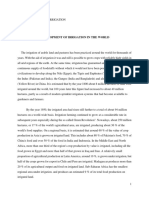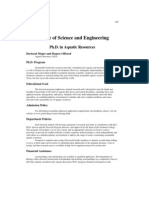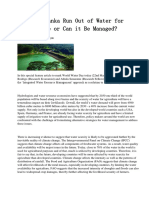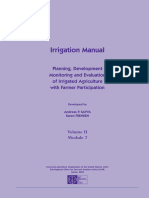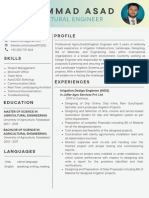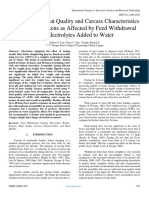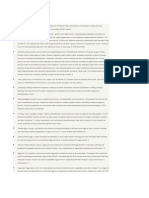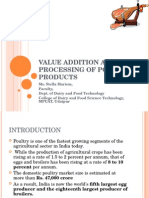0% found this document useful (0 votes)
79 views9 pagesStudy On Economics of Spent Hen Meat Products
Dr. SARVADNYA R GHONGDE
PhD Scholar
Dept. of Livestock Products Technology
CVAS, KVASU
Uploaded by
Dr Sarvadnya GhongdeCopyright
© © All Rights Reserved
We take content rights seriously. If you suspect this is your content, claim it here.
Available Formats
Download as PDF or read online on Scribd
0% found this document useful (0 votes)
79 views9 pagesStudy On Economics of Spent Hen Meat Products
Dr. SARVADNYA R GHONGDE
PhD Scholar
Dept. of Livestock Products Technology
CVAS, KVASU
Uploaded by
Dr Sarvadnya GhongdeCopyright
© © All Rights Reserved
We take content rights seriously. If you suspect this is your content, claim it here.
Available Formats
Download as PDF or read online on Scribd
/ 9
Indian Journal of Natural Sciences oe www insroindia.org.in CONS
Vol / Issue 48 / June /2018 International Bimonthly ISSN: 0976-0997
Reotre putea
Study on the Economics of Spent Hen Meat Puffed Product
Sarvadnya RG", Kokene RD?, Dange Az, Gadekar YP?, Girish PS* and G Venkateshwaralus
'MVSc Scholar, Department of Livestock Products Technology, Bombay Veterinary College,
Mumbai, Inclia
2Department of Livestock Products Technology, Bombay Veterinary College, Mumbai, India.
2Principle Scientist, Central Sheep and Wool Research Institute, Avikanager, Rajasthan, India.
‘Principle Scientist, National Research Centre an Meat, Chengicherla, Hyderabad, Telangana, India.
‘Dean, Central Institute of Fisheries Education, Mumbai, India.
Received: 11 Mar 2018 Revised: 13 Apr 2018 Accepted: 25 May 2018
“Address for correspondence
Sarvadnya RG
MVSe Scholar, Department of Livestock Products Technology,
Bombay Veterinary College,
Mumbai. India,
Email: sarvadnyargegmail.com
«the terms ofthe Creative Commons Attribution License
©OSS sls on Open Accs urate asrioued und
ripution, and reproduction in any medium, provided the
GERRI (CC-BY-NC-ND 50) which permits unrestricted use,
‘original work is properly cited. Al rights reserves
Animal protein is one of the most important food products essential for normal growth of human
body.Incorporation of waste protein (Spent Hen) of poultry industry and thus reducing the cost of
production of Value added Spent Hen Meat Puffed Product was main motto of the following study
(Abdul Latif,2007).The study explains in detail about economic statistics (MOA, 2009) of production since
from the incorporation of spend hen meat and other ingredients required for the production of Spent hen
meat puffed product to its final use (Shaaban Abdel,2004). The present study was aimed at economic
study of value added Hot Extruded puffed product by incorporation of spent hen meat emulsion in the
flour in various proportions. Spent hen meat emulsion and two flour mixtures (Corn flour and Rice flour)
Were admixed in 15:85 (Ti), 20:80 (T:) and 25:75 (12) proportions to obtained emulsion based dough to
produce hot extruded puffed product. Hot extruded puffed products thus obtained by twin screw hot
extruder were rich in protein because of incorporation of spent hen meat which possessed almost 10-15%
protein. Puffed product from flour mixture admixed with spent hen meat emulsion in different
proportion can be effectively manufactured by using twin screw hot extruder. Puffed products produced
were studied for the economic survey comparing other meat products in the meat industry and also tried
to adopt the best possible methodology of production of cheapest form of highly Value added puffed
products in meat industry (Mustafa Ibrahim,2003)
Key words: Extrusion,Cooking,Puffed, Swollen
aie 14012
Indian Journal of Natural Sciences oe www tnsroindia.org.in CLHIONS
Vol8 / Issue 48 / June /2018 International Bimonthly ISSN: 0976 - 0997
Sarvadnya et al.
INTRODUCTION
‘The Meat and Poultry Industry Economic Impact study measures the combined impact of the meat processing,
poultry processing, hide and skin production and offal production industries (hereafter meat and poultry products)
‘The industry Is defined to Include not only the production of meat and poultry based products, but meat distribution
and retailing. The protein products of animal food contain different amino acids and fals, which are necessary for
normal growth of human body, As a result of constant increase In population, the demand (Dhehibi, 2002) Increased
for animal protein praducts of various types such as red meat, fish or poultry due to awareness for health and
nutrition (Elhawary, 1992). Also, the average per capita Income Is one of the most Important Indicators of the
progress or fallure of States. A study of the demand (Deaton, A 1980) of necessities of life requires high degree of
importance. It is an admitted fact that the living standards of members of the community and the spending on 2
particular commodity or a certaln group of food items are heavily Influenced by the level of overall spending on the
sels of goods and services,
Extrusion is a process in which material is pushed through an orifice or a die of given shape. The pushing force is
applied using twin-screw extruder. Extrusion pracessing af food materials has became an increasingly important
manufacturing methad, and its application has broadened substantlally In the last two decades (Karwe MV., Food
extrusion vol. II), The principle of operation is: rawy materials are fed into the extruder barrel and screw(s) pushed
toward die and cutter. From transport phenomenon, extrusion pracess can be a combination of several processes
such fluid flow, heat and mass transfer, mixing, shearing, particule size reduction, melting, texturizing, caramelizing,
shaping and forming of different types of product (Karwe M.V., Food Process Engineering). Depending on the
product, one or many of these processes will take place in an extruder Economic development is normally
accompanied by improvement in country food supply and gradually eliminates the problem of nutrient deticiency.
India is number one in livestock population with poultry population of 613 million, Livestock sector contributes
approximately 4% to GDP and 27% to agricultural GDP (Kumar, 2008). In addition to providing nutritional security
to the poor, it offers employment to millions of people in rural areas. The world production of various kinds of meat
Is 281.6 MT out of which India’s share is 4.19 MT (FAO, 2009). In comparison with other livestock sectors, the poultry
industry in India is well organized and progressing towards modernization. The rapid growth of poultry industry
during the last four decades has made our country one of the largest producers of broiler. Today poultry is one of the
fastest growing segments of the agricultural sector in India and now the world's third largest egg producer and the
Titth largest producer of broilers.
‘Among the various classes of poultry birds, broilers are heavier in body weight and contain high fat (Kondalah et al.
1993). The availability of culled and spent hens has also increased many folds with rapid development of poultry
layer industry. Spent hens are those birds of poultry industry whose egg laying capacity is over. The meat from spent
hen Is generally tough, less tender and poor in functional properties, because of Its Increased collagen content and
cross linkages (Balley, 1984) Unfortunately, the toughness prevents spent hens use In whole meat food and reduces
the market value in many countries such as Korea, Taiwan, Japan and United state (Sams, 1990,, Nowsad et al, 2000 2
and b., and Lee et al, 2003).As the egg laying capacity of layer bird is absolute, the farmers have to face a problem
discarding spent hen. The disposal of layer hens is one of the rain economical and environmental problems of the
poultry industry. Egg producer worldwide disposes off 26 billion spent hens usually after they have finished their
laying cycle (Singh etal, 2001)
Hence, attempt should be made for obtaining better returns by the way of adopting suitable methods for economic
Utilization of spent hens. Spent hens are usually slaughtered and used in feed production and concentrated stock
preparations, or sold for domestic consumption in soups and stews (Ajayah et al,1992., and Voller- Reasonover et al,
1997). However, a better use of hens at the end of laying cycle, for example in the manufacturing of food products
with higher added value, could provide economic profits. Fast food is one of the world's largest growing sector
India’s fast food industry grew by 40% and generated a billion dollars in sales by 2005 (MFPI, 2005). In last six years,
mE 14013
aval
Indian Journal of Natural Sciences oe www. tnsroindia.org.in CONS
Vol8 / Issue 48 / June /2018 International Bimonthly ISSN: 0976 - 0997
Sarvadnya et al.
‘foreign invesiment in this sector stood at Rs. 3600 million, which Is about one-fourth of total investment made in this,
sector. The snack products, which are mostly available in large amounts in the market (Hamid Mohammed, 1996) are
‘made of cereals, which are high in carbohydrates and fat but low in protein, The snack foods cover a wide range of
food products. They are consumed as a light meals or a partial replacement for a regular meal. Snack foods could be
redesigned to be nutritious, contain ingredients which are attractive to consumers, and meet regulatory requirements
(Shukla, 1994). When meat is used in a snack based products it provides some nutritional diet through the products
to the consumer. They are many ingenious varlations in the processes used by the Industry, which serve to increase
the range of products manufactured. Utllization of spent hen meat In the snack products will increase the palatability
and nutritional value of such foods.
Extruded putfed snacks are usually made from degermed corn or corn grits, wheat, rice or other cereals. There has
been a remarkable growth In the varieties and popularity of such products because they are easily affordable, tasty,
easy to make and nutritive, These products are flavoured with cheose, spices, onion, garlic or chilly and broadly fall
In the fast food category. The popularity of extrusion technologies has increase in last two decades because of the
following reasons:
> Extrusion cost operation has lower and higher productivity than other heating and forming processes;
> Costs of extrusion operation are lower than other operations like heating and forming processes in food industry;
> Faster time processing reduces energy consumption,
Blending of flours with meat in place of ather vegetable products have not been tried yet in extrusion process. The
present study was thus planned to study the economics of puffed produets from spent hen meat.
MATERIALS AND METHODS
“The present study on economics of hot extruded puffed product from spent hen meat was done in various phases,
The materials used and methadology employed during the study are discussed here under
Source of raw materials for the production of spent hen meat puffed product
Spent hen meat
Approximately 72 weeks old spent hens reared at the Poultry Science Department of Bombay Veterinary College,
Parel were procured, slaughtered and dressed according to traditional halal method (Shaaban Abdel,2002). The body
{at was removed and deboning of dressed spent hen was done manually removing all tendons and separable
‘connective tissues. Fresh spent hen meat thus obtained was used for further processing immediately.
Ingredients mixture
The ingredients mixture formula for spent hen meat emulsion shown in Table 1 was formulated on the basis of
preliminary trials conducted in the Department of Livestock Products Technology, Bombay Veterinary College
Mumbai. Different proportions of ingredients were tried for one kg lat of spent hen meat emulsion in the preliminary
trials,
Experimental details
To standardize spent hen meat emulsion based dough suitable for puffed product preparation
“The procedure far emulsion based dough from spent hen meat was standardized after several preliminary trials for
‘one kg lot of spent hen meat emulsion based dough
aie 14014
aval
Indian Journal of Natural Sciences oe www tnsroindia.org.in CLIONS
Vol.8 / Issue 48 / June (2018 International Bimonthly ISSN: 0976-0997
Sarvadnya et al.
of spent hen puffed product
at (41°C for 12 hrs)
wfion
Addition of different levels of flours in emulsion
th tT Ts
(Flour mixture was comprised of 60% Corn flour + 40% Rice flour)
Emulsion biked dough
Hot extrusion (104°C)
muted etc
Where: =
‘Ti (15%emulsion 85% flour mixture)
‘Ts (20%emulsion 80% flour mixture)
‘Ts (25%emulsion 7524flour mixture)
Extrusion of Puffed product
ABTPL laboratory scale twin screw extruder was used in Department of fish processing, Central Institute of Fisheries
Education, Mumbai (Fig.1) in the present study. The exirusion cooking was done on a twin screw extruder (BTPL
LST EB10), The power of the motor kept ata speed (350 rpm) is 7.6 KW. A full-actorial design (two factors each at
three levels and three replicates) was employed. Screw speed was kept constant (350 rpm) during the experiment.
Moisture contents of the extrusion feeds were 143, 175, and 21.0%, respectively. The extruder ternperature was set at
104°C where as barrel temperature was maintained 140%. Feed rate of volumetric feeder equipped with twin scrow
was set ldgm/min. A 2 mm circular die was used for extrusion. Materials to be extruded (emulsion and flour
mixture) were mixed and formed dough and put into feeder hoop to reach the feed for extrusion. The moisture
content of the feed analysed for which sampling done before putting to feeder hoop and kept the sample into hot air
over for moisture analysis. Extruded product coming out the sieve (die) was collected in clean tray and sampling is
done in twa lots and packed in polythene bags among which one for sensory evaluation and another for chemical
and microbial analysis.
mE 14015
aval
Indian Journal of Natural Sciences oe www. tnsroindia.org.in CIJONS
Vol.8 / Issue 48 / June /2018 International Bimonthly ISSN: 0976 - 0997
Sarvadnya et al.
Economics of the puffed product
‘The economics of the puffed product prepared from spent hen meat was also worked out on the basis of present cost
of various ingredients and cost of other processing parameters.
Stat
ical analysis
‘The data obtained during the experiment were analyzed by Analysis of Variance following standard procedure
(Snedecor and Cochran, 1989).
RESULTS AND DISCUSSION
‘The present study on Economics of hat extruded puffed product from spent hen meat was performed in varlous
phases al the departments of Livestock Products Technology of Bombay Veterinary College and Fish Processing
Department, Central Institute Fisheries Education, Varsova, Mumbai. In the initial stages of the experiment stable
emulsion from spent he was obtained after altering the process used for emulsion from broiler meat (Omar Ahmed,
2002). The proper dough consistency was determined after several trials on varlous combinations of different types
and levels of flours and spent hen meat emulsion to obtain a proper hot extruded puffed product. Various sieve sizes
_were also tried in the preliminary stucly and finally 2 mm diameter sleve size was used for extrusion
‘The moisture content of the feed, extrusion temperature and barrel temperature are very Important for the
manufacture of puffed products. Accordingly on the basis of preliminary trials the moisture content of the feed was
maintained in the range of 14 to 22 percent for different treatments under study.The barrel temperature was
maintained at 140°C to obtain the extrusion temperature 104°C. The steps / processes used in the preliminary trials
‘were selected on the basis of suitable dough quality which was giving proper hot extruded puffed product. Thus the
three treatments (Ts - 15% emulsion + 85% flour mixture, Tz - 20% emulsion + 80% flour mixture and Ts - 25%
emulsion + 75% flour mixture)(Fig 2,34) as discussed above were finalized and were replicated four times. The
results obtained are discussed In the present paper.
‘The dough obtained for three different treatments wore extruded through laboratory scale twin screw extruder at
extruder temperature 104°C in 350 rpm speed and 2 mm diameter sieve size separately. Spent hen puffed product
(SHPP) thus obtained from each treatments were divided into {wo lots, The first lot was used for sensory evaluation
and zero day analysis. Second lot was aseptically packaged in polyethylene bags and kept in airtight container to
‘monitor the shelf life at regular interval
Economics of SHPP
‘There are varieties of puffed products throughout the world which are famous with their typical manufacturing
processes. The puffed products are very famous at the urban level in Indian continents which are manufactured by
Using different flours. Incorporation of spent hen meat in different flours used for puffed product making Is one of
the thoughts of value addition of spent hen meat. Puffed products are now very famous in a generation of all ages
Looking at the popularity ofthis food, it was also decided to work out the economics of the spent hen meat puted
product (SHPP) (Fig.8) in the present study. For this purpose cost of spent hen meat emulsion was worked out by
considering the existing market prices (Mustafa Ibrahim Abu-Saad, 2003) of different ingredients and the proportion
Used for the spent hen meat emulsion as depicted in Table 2
{As depicted in Table 3 a cost of one kg spent hen meat emulsion was estimated as Rs. 63.51 (Moschini, G., 1998) by
considering the present cost of all the ingredients required for emulsion formulation. While calculating the cost of
mE 14016
aval
Indian Journal of Natural Sciences oe www tnsroindia.org.in CLIONS
Vol.8 / Issue 48 / June (2018 International Bimonthly ISSN: 0976-0997
Sarvadnyar et al.
puffed product (SHPP) apart from cost of emulsion, cost of various processing parameters as depicted in Table were
‘considered. From the Table 4 itis clear that the cost of spent hen puffed praduct (SHPP) after considering all the
parameters and after extruding was Rs, 45.65, 48.37 and 51.08 respectively for Ts, Te and Ts The average yield
‘observed in the present study for hot extruded puffed product was 80 percent for all the treatments. The higher cost
of Ts followed by Te and T; was because of higher proportion of spent hen meat in the formulations.
REFERENCES
1. AOAC. (1995) Official method of analysis. 15% Edition, Association of Analytical Chemists, Washington D. C:
USA.
2. Anisworth, P. lbanoglu, $.: Hayes, 6.0.(1997) Influence of process variables on residence time distribution and
flow patterns of tarhana in twin-screw extruder. Journal of Food Engineering 1997, 37, 101-108.
3. Anjaneyulu, A. S. RN. Sharma and N. Kondaiah (1988) Effect of salt and phosphate preblending on quality of
buffalo meat during frozen storage acceptability of patles. Indian J. Meat Sci, Technol, 1(2): 135-144
4, Anjaneyulu, A. S.R., N. Sharma and N. Kondaiah (1986) Evaluation of salt, polyphosphate and their blends at
different levels on physico-chemical properties of buffalo meat and patties, Meat Sc, 25: 293-306.
5. Deaton, A. and J. Mucllbauer, 1980, An almost ideal demand system. Am. Econ. Rev., 70: 312-26
6. Ohehibi, 8. and JM. Gil, 2003, Forecasting food demand in tunisia under alternative pricing policies, Food Policy,
28: 167-186,
7. Ethawary, €.Z.,1992. Estimating an almost idel demand system for meat. Egypt. J. Agric. Econ.,2: 20-28.
8. F Abdo Younis,(1994) economics of production, marketing and pricing of red meat in Egypt, Master Thesis,
Department of Agricultural Economics, Faculty of Agriculture, Alexandria University, 19%.
9. FAO (2009) Food and Agricultural Organization of the United Nation
10, Green, R. and 1M. Alston, 1990. Elasticities in AIDS models. Am.J. Agric. Econ., 72: 442-445.
11, Hedy EO. and Dillon J L., Agricultural production fanetion Low astate university press Ameslows 1961
12. Hedrick, H.B., ED. Aberle, LC. Forrest, M.D. Judge and RA. Merkel (1994) Principles of meat Science,
Kendall/Hunt Publishing Co, Lowa
13, Huber, GR,, (2000) Twin-screw extruders, Extrude in food application, CRC Press, pp 81-114
14.Jabarin, AS., 2006, Estimation of meat demand system in Jordan: An almost ideal demand system, Int. J
Consumer Stud, 29: 232-238
18, Kondaiah N. (1990) Poultry meat and its place in market. Poult. Guide, 27: 41-46,
16. Kondaiah N., A. §.R. Anjaneyulu, N. Sharma and H. 8. Joshi, (1985) Effect of salt and phosphate on the quality of
btfalo and goat meat. Meat Sci, 15: 183-192
17. Kondalah,N. (1993) products trom spent hen, poultry International 1993: 49(1: pp 46-47.
18. Kumar, A: Ganjyal, GM. Jones, D.D.; Hanna, M.A (2008) Digital image processing for measurement of residence
time distribution ina laboratory extruder. Journal of Food Engineering 2006, 75, 237-244
19. Kumar Pawan (2008) Indian Poultry industry Challenges and Opportunitieswww. rabobank com/far.
Karagiannis, G.,$. Katranidis and K. Velentzas, 2000, An error correction almost ideal demand system for meat in
Greece. Agric. Econ. 22: 29-35.
20, La France, JT, 2004, Integrabilty ofthe linear approximate Almost Ideal Demand System (AIDS). Econ, Lett, 88
297-208,
21, MFPI (2008) A report on Indian Food Processing Industry. Annual Report of Ministry of Food Processing India
22, MOA, 2009. Agricultural production statistics. Ministry of Agriculture, Kingdom of Saudi Arabia. Annual Report,
pp: 215.
23, MOCI, 2009. Annual report 2009. Ministry of Commerce and Industry, Riayhd, Kingdom of Saudi Arabia
Moschini, G., 1995, Units of measurement and the stone price index in demand system estimation, Am. J. Agric.
Econ., 77: 63-8.
mE 14017
Indian Journal of Natural Sciences oe www tnsroindia.org.in CLIONS
Vol / Issue 48 / June /2018 International Bimonthly ISSN: 0976 - 0997
Sarvadnyar et al.
24, Moore, G.(1994) Snack food extrusion. In The Technology of Extrusion Cooking, Frame, N.D., Eds; American
Association of Cereal Chemists: St Paul, MN, 1994; 111-143
25, Naveena, B. M., and S. K, Mendiratta (2001) Tenderization of spent hen meat using ginger extract Br. Poult. Sci
42:344-349.
26, Owen, A., 1999, Emprical likelihood ratlo confidence regions. Ann, Statist, 18: 90-120
27. Omar Ahmed, Ahmed Badr (2002) “Analytical Economic Study of the factors affecting the procluction of red meat
in Egypt’, PhD, Department of Agricultural Economics, Faculty of Agriculture, Zagazig University,
28, Shukla, TP. (1994) Future snacks and snack food technology, cereal Foods World 39: 70470.
29, Singh, S., 8. Gamlath and L. Wakeling (2006) Nutritional aspects of food extrusion: a review, International Journal
of Food Science and Technology 2007, 42, pp 916:928.
30, Snedecor , G. W. and W. J. Cochran (1989) Statistical Methods, 8% Edn; lowa State University press, Amer. Lowa,
USA
31, Shaaban Abdel gaied Abd al-Mumin Abd al-Raziq (2004) “an economic study of the factors affecting the meat
production in Egypt", PhD, Department of Agricultural Economics, Faculty of Agriculture, Al Azhar University,
1999. 8 Shawki Amin Abdel Aziz Salim, an economic study of the problem of red meat in Egypt, Journal of
Menoufiya Agricultural Research, Volume XXIX, Issue Ill, June 2004
32, Shaaban Abdel -Abd al-Mumin Abd al-Raziq(2004) “an economic study of the factors affecting the meat
production in Egypt, PRD, Department of Agricultural Economics, Faculty of Agriculture, Al Aznar University,
1999. 8 Shaw Amin Abdel Aziz Salim, an economic study of the problem of red meat in Egypt, Journal of
Menoufiya Agricultural Research, Volume XXIX, Issue Ill, June 2004
33, SAS, 1984, Statistical Analysis System (SAS) User's Guide. Version 5. SAS, Institute Inc, Cary, NC, USA.
34, Mahmoud Ezzat Abdul Latif(2007) an economic study for the production and marketing of red meat in Beni
Suef, Arab Republic of Egypt, Department of Agricultural Economics, Faculty of Agriculture, Ain Shams
University, 2007
35, Mustafa Ibrahim Abu-Saad: Hassan AbdolMeguid Abdel-Maksoud and Hassan Nabi Iorahim,(2003) “an
economic study of the efficiency of the marketing of red meat 2 case study in Menoufiya governo’
Menoufiya for Agricultural Research, Volume XXVIII Issue VI, December, 2008,
36, Qin, J. and J Lawless, 1994. Empirical likelihood and general estimating equations, Ann, Statist, 22: 300-325,
te" Allournal
Table 1. Ingredients used in formulation for spent hen meat emulsion
Ingredients ‘Quantity in ©)
‘Spent hen deboned meat 90.59
‘Common salt 3
Vegetable ott 6
Sodium nitrite or
Sodium polyphosphate o4
‘Table 2. Composition of dough for hot extruded spent hen puffed product
Treatments | oportion ofemulsion | Proportion of our | yy5.4 ot gue
: 5 sae
n 0 ® ‘aor rou
By % i ‘as Tour
NOTE: T: (Dough with 15% emulsion), T(Dough with 20%emulsion),T3 (Dough with 25% emulsion)
mE 14018
aval
Indian Journal of Natural Sciences ed www tnsroindia.org.in CLIONS
Vol8 / Issue 48 / June /2018 International Bimonthly ISSN: 0976 - 0997
Sarvadnyar et al.
Table 3. Cost of one kg spent hen meat emulsion
Sr.No. _| Ingredients ‘Oty (gms) Rate(Rs/kg) | Emulsion cost in Rs/kg
1 Meat 915.9 60 54.95
2 Salt 20 18 (00.36
3 Oil 60 90 05.40
4 Sodium nitrite [0.7 42 00.64
5 STPP 4 540 02.16
‘Cost of one kg emulsion 651
‘Tabled. Cost of one kg spent hen meat puffed product (SHPP)
Ti tr tr
StNo. | Ingredients Gly | Cost | Oly] Cost | Oly] Cost
@ | es) | @ | @) | @ | es)
Emulsion (Rs./kg)_| 6351 150 | 952 | 200 | 1270 | 260 | 15.87
2__[ Corn flour (Rs/kg) | 20.00 | 810 | 10.20 | 480 | 09.60 | 460 | 09.00
3 Rice flour (Rs/kg) | 20.00 | 340 | 0680 | 320 | 06.40 | 300 | 06.00
Hot extrusion cost
4 (avg. 10 mins. / | Rs.60/hr 10 10 10
batch of one_kg)
5 Yield (%) 30 800 800 800
‘Actual cost of SHPP_
6 (Reg) 45.65 48.37 51.08
NOTE: T:- Dough with 15% emulsion, T:-Dough with 20%emulsion, T3- Dough with 25% emulsion
Fig 1. Twin screw extruder (Department of Fig.2: Hot extruded puffed product prepared
fish processing, Central Institute of Fisheries with 15 % emulsion and 85% flour mixture (T1)
Education, Mumbai)
- 14019
BE
Indian Journal of Natural Sciences ed swww.tnsroindia.org.in ©LJONS
VoL8 /Issue 48 / June /2018 International Bimonthly ISSN: 0976-0997
Sarvadnyar et al.
Fig.3: Hot extruded puffed product Fig.4: Hot extruded puffed product
prepared with 20 % emulsion and 80% flour prepared with 25 % emulsion and 75%
mixture (12) flour mixture (T3)
Fig.5: A sample of dough prepared for the preparation of hot extruded puffed product (SHPP)
aie 14020







